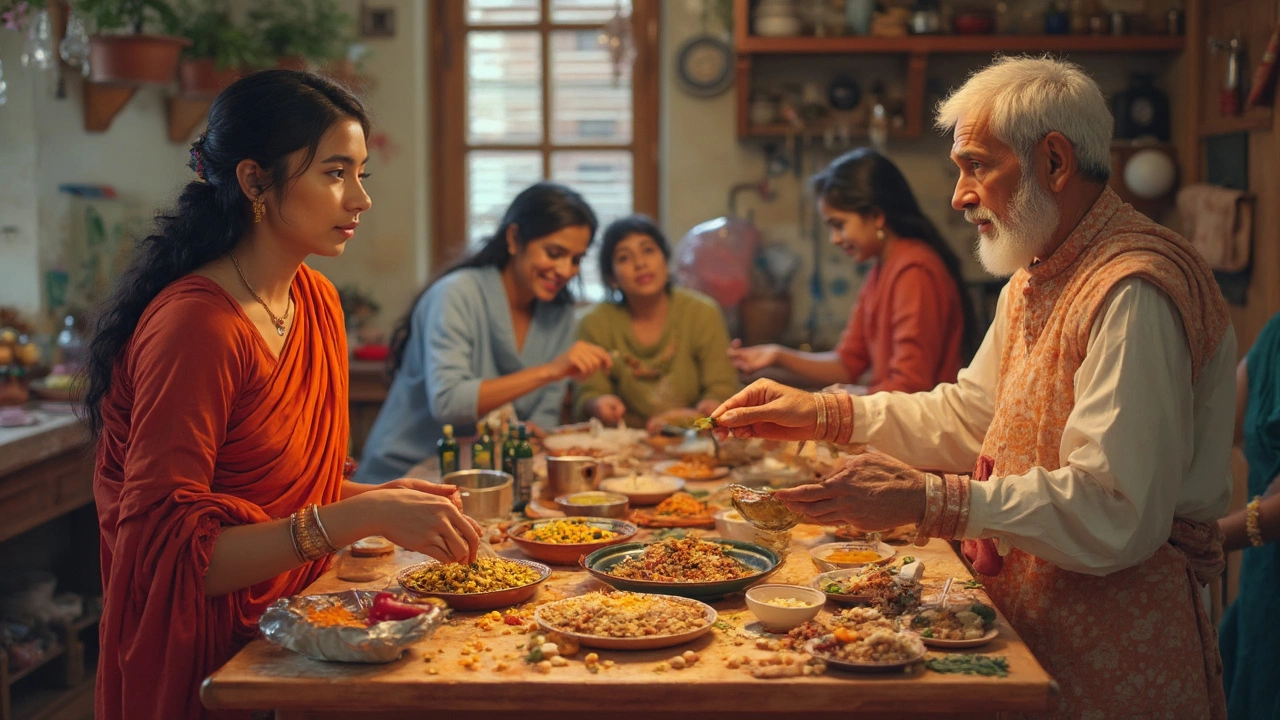You know the feeling—you're craving a snack, but don't want to derail your healthy eating plans. Indian food, known for its rich flavors and diverse ingredients, can be tricky when you're counting calories. But not all Indian snacks are loaded with ghee and deep-fried goodies. Let's dive into some tasty options that let you indulge without the guilt.
Many traditional snacks get their bad rap because they're packed with oil or sugar. But the secret to enjoying Indian snacks lies in understanding the ingredients. For example, you might find puffed rice, gram flour, and whole grains making a healthy base. These not only keep things light but are also packed with nutrients.
- Understanding Indian Ingredients
- Top Non-Fattening Indian Snacks
- Smart Cooking Tips
- Balancing Flavor and Health
Understanding Indian Ingredients
Diving into healthy Indian snacks means getting a solid grip on the ingredients used. Indian cuisine is built on a diverse palette of spices, legumes, grains, and vegetables—each bringing its own nutritional profile to the table.
Spices: Flavor Without Calories
Spices like turmeric, cumin, coriander, and mustard seeds pack a punch with flavor but are virtually calorie-free. Turmeric, for instance, is not just bright yellow; it has anti-inflammatory properties too. These spices help in spicing up your food without adding unnecessary calories.
Legumes and Lentils: Protein Powerhouses
Lentils and beans like chickpeas or black-eyed peas are staples in many Indian snacks. They're rich in proteins and fibers, making them perfect for those on a low-calorie diet. Think about snacks like roasted chickpeas—crunchy and filling without guilt.
Whole Grains: The Key to Satiety
Whether you’re munching on puffed rice or enjoying a flatbread, whole grains keep you full for longer. Plus, they're often more nutritious than their refined counterparts. Millet, for instance, is gluten-free and rich in nutrients, making it a great alternative to rice or wheat.
Fruits and Vegetables: Nature's Fast Food
Fruits and veggies are key players in low-calorie Indian food. They’re not only packed with vitamins and minerals but also add a natural sweetness or crunch to snacks. Cucumber or carrot sticks with a dash of chaat masala can be immensely satisfying.
| Ingredient | Benefits |
|---|---|
| Turmeric | Anti-inflammatory, bright color |
| Chickpeas | High protein, fiber content |
| Millet | Gluten-free, nutrient-dense |
Understanding these ingredients helps in choosing the right snacks. Switching things up with these healthy options will not only please your taste buds but also contribute to a balanced lifestyle. So next time you reach for a snack, remember these ingredients are your best friends!
Top Non-Fattening Indian Snacks
Craving something tasty but worried about the calories? It is possible to enjoy healthy Indian snacks without the extra guilt. Here are some popular snacks that are both lip-smacking and low on calories.
Bhel Puri
This street food favorite is made with puffed rice, veggies like onions and tomatoes, and a tangy tamarind chutney. It's light yet crunchy and can be quickly whipped up at home to cut back on any additional oils used in roadside stalls.
Sprout Salad
A burst of freshness and nutrients, sprout salad usually combines sprouts with chopped cucumber, tomatoes, and seasonal fruits. It's a perfect blend of vitamins and a quick boost of energy with minimal calories. Often seasoned with lime and a pinch of chaat masala, it's an excellent on-the-go option.
Dhokla
A staple from Gujarat, dhokla is steamed rather than fried, making it a low-calorie Indian food. Made with fermented gram flour, it’s light and also rich in proteins. You can have them plain or with a slight topping of mustard seeds and coriander.
Ragi Chips
If you're into chips but avoiding the greasy kind, ragi (finger millet) chips are your answer! They're baked, packed with fiber, and surprisingly filling. Pair them with a homemade yogurt dip for a refreshing twist.
Fruit Chaat
This is basically a vibrant mix of your favorite seasonal fruits, sprinkled with a bit of chaat masala. It’s a burst of flavors that's naturally sweet and doesn’t require any added sugar. Perfect for summer days when you need something to cool off.
Making the right snack can change the way you view your diet. Indian cuisine offers plenty of options where taste doesn’t have to be sacrificed for health. Keep these options in mind next time you're reaching for a snack!

Smart Cooking Tips
Cooking Indian snacks at home means you can control what goes in, which is the key to keeping them non-fattening. Here are some practical hacks to lighten up your favorite treats without losing out on flavor.
Bake, Don’t Fry
While samosas and pakoras are the darlings of Indian snacks, they're usually fried. Swap frying for baking! Simply brush your samosas with a little olive oil and pop them in the oven. You’ll get that brilliant crunch without the extra calories.
Use Whole Grains
Whole grains like brown rice or quinoa can replace white rice or refined flour in many recipes. They not only cut down on empty calories but are also packed with fiber, keeping you fuller for longer.
Start Steaming
Steamed snacks like Dhokla or Idli are naturally low in fat. They're great as they don’t require oil and yet are incredibly satisfying.
Spice it Right
Spices are your best friends in Indian cooking. They add flavor without adding calories. Season snacks generously with turmeric, cumin, or coriander for a low-calorie flavor boost.
Keep Portions in Check
No matter how healthy a snack is, eating too much of it can still add up. A rule of thumb? Stick to small bowls or plates. It's a simple way to control serving sizes without overthinking it.
| Cooking Method | Effect on Calories |
|---|---|
| Frying | Increases calorie content significantly |
| Baking | Reduces calorie content by up to 50% |
| Steaming | Minimal effect on calories |
Balancing Flavor and Health
When it comes to enjoying healthy Indian snacks, finding a balance between taste and nutrition is key. Indian cuisine is unique because it uses a lot of spices, which not only add flavor but actually pack health benefits. Think turmeric for its anti-inflammatory properties or cumin for digestion.
To keep your snacks tasty yet light, focus on cooking methods. Grilling, steaming, or baking can maintain flavor without excess oil. Swap out frying for baking with popular snacks like samosas or pakoras. You still get that crispy texture without the added calories.
Choosing the Right Ingredients
Simple ingredient swaps can make a big difference. Use chickpea flour instead of refined flour to boost protein and fiber. Try cooking with coconut oil or mustard oil in moderation—they add their own flavor and are healthier fat options.
Spicing Up Your Snacks
Spices do wonders without adding calories. A pinch of cardamom in your tea or chili powder in your roasted chickpeas enhances flavor profiles while keeping it nutritious. An interesting fact: a small sprinkle of asafoetida (hing) can elevate the taste of lentils or beans while aiding digestion.
Mindful Portion Control
Even with low-calorie snacks, portion size matters. A handful of roasted nuts or a bowl of steamed dhokla can be satisfying without overdoing it.
- Roasted moong dal—rich in protein and crunchy.
- Sprouts salad—tossed with lemon juice and spices for a refreshing kick.
- Khakhra—a thin, crisp snack from Gujarat, perfect for munching.
Remember, snacking can be a joy rather than a guilty pleasure. By balancing flavor and health, you're not just enjoying food but also fueling your body in a smart way.
